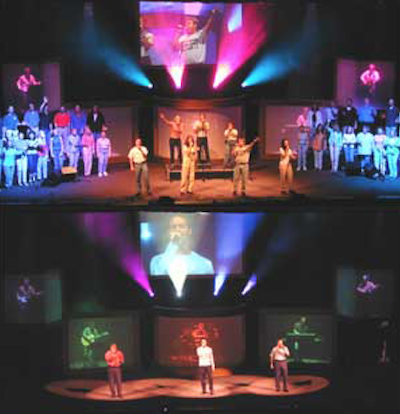Churches and the Electronic Canvas Instead of IMAG
I posted an article here on rAVe I wrote about IMAG (Image Magnification — live video projected onto a screen) and stated that it was overused in small venue churches where it wasn’t difficult to see the action on the stage without a live video image. There are times where limited usage of live video for infrequent events can help, such as a hard-to-see baptistry. But to try and use IMAG for the majority of each service in anything less than a huge venue? That’s where I’m saying let’s rethink IMAG and use those screens more effectively as an electronic canvas.
What could churches put on the screens during the sermon instead of IMAG?
IMAG is limiting
When using live video of the singer or pastor projected up on the screen, the ability to creatively use the available screen space is suddenly very limited. You can replace the image, add lower-third or side-third graphics or even use DVE (digital video effects) for a picture-in-picture effect for trying to juggle content. In each of these cases, the tools necessary for quality video and overlays is exponentially more expensive and volunteer-intensive than simply using the screen as an open canvas.
There’s a limitless amount of content that can be displayed on a screen at any given time. So in order to best answer the question “What could churches put on the screens during the sermon instead of IMAG?”, let’s think through how our answers can fit into the context of a service.
There has been a ton of research that shows how people best retain information. In each of these studies, a significantly larger proportion of them retain the most information when it is presented in a way where they see, hear and experience the information. With that being the case, if there’s a visual way to reinforce the spoken word, then the electronic canvas is an obvious choice.
Text reinforcement
When a significant point is being presented, reinforce it with text! Some people will even make some of the text fill-in-the-blank style and reveal the missing text as the point is discussed. Another creative way to reinforce text is to tie in an electronic whiteboard that takes what is written/drawn in real time and projects it up on the screen. In this way, the teaching pastor can use the white board interactively for even more retention-building power.
Sermon Starters
Rolling in a video animation with a soundtrack and subtle effects has, on more than a few occasions, set the tone for the message series in a way that would be hard to duplicate with mere words, text or graphics. There are entire libraries of content available on church resources sites such as Worship House Media, Sermon Spice and Sermon Central.

Downloading ready-made videos for church sermon support is a click away.
Man-On-The-Street Videos
Sometimes rolling in a video of short interviews with people on sidewalks, at parks or other public places can help explore what ‘the average person’ thinks about a topic. “What happens when you die?” “Who is a ‘Christian’?” “When did you last do something selfless?” “Why do bad things happen to good people?” “Where do you turn when things are at their worst?”
The answers given to questions like these give us a glimpse into the people in their communities.
Often times the electronic canvas can do more than just reinforce a message. In the same way a great TV series or intense movie can capture our imaginations and draw us into the story, we can use the same emotive responses to propel a message, open up someone’s mind and even tear down a defensive wall. Used before, during or after a message, these tools are begging to be lit up on the electronic canvas.
Art
Sometimes the electronic canvas is really a true, physical canvas. Artwork can speak volumes and help to give substance to a metaphor. In one sermon series at Fellowship Church, a bunch of huge (5-8′ tall by 4-8′ wide) ‘picture frames’ (see below) were spread across the stage. On the front of each was stretched white fabric (scrim material), front projected with artwork.
During one song, the top center ‘picture frame’ (see below) showed the singer in a music video walking toward the camera. As his image filled the ‘painting’ head-to-toe, the lights changed, the projected image faded out and the actual singer stepped through a slit in the canvas of the top center ‘picture frame.’ It was as if he came right out of the video. Simultaneously, the projected artwork on the other picture frames faded out and back lights revealed that the live band was actually inside each ‘picture frame’ box behind the now translucent screen material.

Fellowshipchurch.com’s Masterpiece stage set.
I remember another sermon series where the pastor painted a picture while he taught. In this instance, live video was a great asset — but it wasn’t IMAG of the pastor; instead it showed the painting in progress so all could easily see the artwork progress up close.
Nature
With the proliferation of good quality film and video of nature’s beauty, it’s possible to have the scenic images represent the song lyrics. Most church presentation software comes bundled with stock footage and looped content of nature as a backdrop for adding song lyrics right on top of the video. Systems integrators should consider becoming a reseller of the top software tools such as ProPresenter, Media Shout, or Easy Worship, too.
Help Churches Use Their Electronic Canvas!
There’s not a valid reason for churches to miss taking full advantage of display technology for digitally painting on their existing screens — their electronic canvas. The examples and ideas could go on and on, but I hope that what I’ve written has helped each of you to understand that IMAG isn’t the ultimate use of screens, but instead is a more difficult and limiting use of the electronic canvas.
Have you helped a church steer clear of IMAG when they didn’t need it? Have you seen examples of using projection as the electronic canvas?




